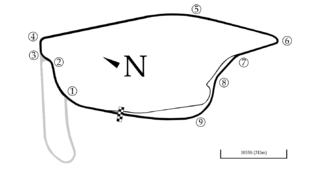Giovanna Amati is an Italian former professional racing driver. She is the most recent female driver to have entered the Formula One World Championship.
Arthur Abrahams) is a semi-retired Australian race car driver. He won the 1987, 1991 and 1993 Australian Formula 2 Championships driving a Cheetah Mk8, Ransburg Cheetah and Reynard 913 respectively. he also won the Australian group C touring car endurance championship (1600cc) in 1984. He competed in International Sportscars in Europe and in American open wheel racing cars. He also competed in Formula Brabham/Holden for three years, debuting in 1994 and leaving the category in 1996. He was owner of the NRC International team in Formula Holden before running Dale Brede amongst others in V8 Supercar's Development Series. In 2001 Abrahams stepped away from the sport to focus on his and family business interests.

Formula Holden was an Australian open wheel racing category introduced in 1989.

Cheetah Racing Cars was a prolific Australian manufacturer of race cars. The cars were almost solely designed, engineered and constructed by Brian Shead in a small factory at the rear of his home in Mordialloc, a suburb of Melbourne, Australia.
The 1991 Formula 3000 International Championship was the seventh season of Formula 3000 in Europe. Christian Fittipaldi won the championship after ten rounds.
Gary Anderson is a British semi-retired racing car designer and motorsport pundit/commentator.
Tomas Mezera is a naturalised Australian racing driver. Mezera won the 1988 Bathurst 1000, and for many years was a member of the Holden Racing Team as both a driver and team manager. Mezera's sporting career began as a downhill skier in his native Czechoslovakia, before he emigrated to Australia to be a ski instructor. Mezera retired from racing in 2004 but continues to hold roles in motorsport, most recently as a driving standards advisor to several domestic motor racing championships.

The Indonesian Grand Prix was an open-wheel racing car motor race, held intermittently as motorsport ambitions varied in Indonesia.
The 1994 Australian Drivers' Championship was a CAMS sanctioned motor racing competition open to drivers of racing cars complying with CAMS Formula Brabham regulations. The championship winner was awarded the 1994 CAMS Gold Star as the Australian Champion Driver. It was the 38th running of the Australian Drivers' Championship and the sixth to feature the Formula Holden / Formula Brabham category which had been developed during 1988. The championship began on 17 April 1994 at Eastern Creek Raceway and ended on 28 August at Oran Park Raceway after six rounds.
The 2003 Australian Drivers' Championship was a CAMS sanctioned national motor racing title for drivers of cars conforming to Formula 4000 regulations. The title was contested over a six-round, twelve race series which was promoted as the 2003 Holden Australian Drivers' Championship for the CAMS Gold Star. It was the 47th Australian Drivers' Championship.
The 2001 Australian Drivers' Championship was a CAMS sanctioned national motor racing title for drivers of cars conforming to Formula Holden regulations, with the winner awarded the 2001 CAMS Gold Star. This, the 45th Australian Drivers' Championship, was promoted as the 2001 Holden Australian Drivers' Championship.
The 2000 Australian Drivers' Championship was a CAMS sanctioned national motor racing title for drivers of cars conforming to Formula Holden regulations. The title was contested over an 8-round, 16 race series with the winner awarded the 2000 CAMS Gold Star. The championship, which was promoted as the 2000 Holden Australian Drivers' Championship, was the 44th Australian Drivers' Championship and the 12th to be contested with Formula Holden or Formula Brabham cars.
The 1998 Australian Drivers' Championship was a CAMS sanctioned Australian motor racing title for drivers of cars conforming to Formula Holden regulations. The title was contested over a six-round, twelve race series with the winner awarded the CAMS Gold Star. Officially the "Holden Australian Drivers' Championship for the CAMS Gold Star", it was the 42nd Australian Drivers' Championship.

The 2000 New Zealand Grand Prix event for open wheel racing cars was held at Pukekohe Park Raceway near Auckland on 2 December 2000. It was the forty-sixth New Zealand Grand Prix and was open to Formula Holden cars. The event was also the final race of the 2000 Tasman Cup. It would prove to be the final race in the revived Tasman Series established in 1998 for Formula Holden. No 2001 series followed.

The Reynard 92D is an open-wheel formula race car, designed and developed by Malcolm Oastler, and constructed and built by Reynard Motorsport, for use in Formula 3000 categories, Formula Nippon and Formula Holden racing series, in 1992.
The Reynard 95D is an open-wheel formula race car, designed and developed by Malcolm Oastler, and constructed and built by Reynard Motorsport, for use in Formula 3000 categories, Formula Nippon, and Formula Holden racing series', in 1995.

The Reynard 94D is an open-wheel formula race car, designed and developed by Malcolm Oastler, and constructed and built by Reynard Motorsport, for use in Formula 3000 categories, Formula Nippon, and Formula Holden racing series', in 1994.
The Reynard 90D is a Formula 3000 car, designed and developed by Malcolm Oastler, and constructed and built by Reynard Motorsport, in 1990.
The Reynard 97D is an open-wheel formula race car, designed and developed by Malcolm Oastler, and constructed and built by Reynard Motorsport, for use in both the Japanese Formula Nippon, and later the Australian Formula Holden series, in 1997.

The Reynard 93D is an open-wheel formula race car, designed and developed by Malcolm Oastler, and constructed and built by Reynard Motorsport, for use in Formula 3000 categories, Formula Nippon, and Formula Holden racing series', in 1993.





